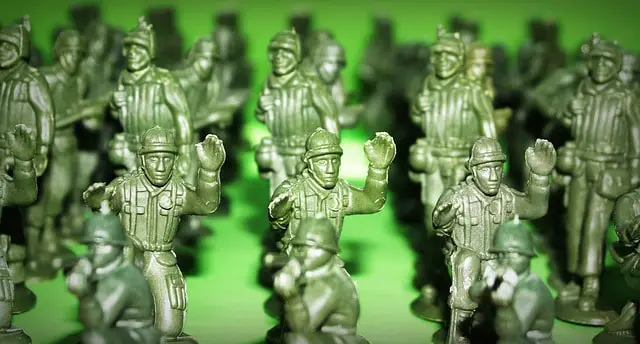When it comes to classic toys, few have stood the test of time quite like the old green army men sets from the 1970s. These small plastic soldiers captured the imaginations of children across America and beyond, providing hours of entertainment and imaginative play.
It was a simpler time since video games were in their very early infancy and the Internet didn’t exist. Playing with toy soldiers in the house or backyard was a common thing for kids particularly boys. The cheapest sets were sold through full-page ads in comic books with headlines like “100 toy soldiers for $1.25.”
In this article, we’ll take a closer look at the history of these iconic toys, exploring their origins, popularity, and enduring legacy.
History
The origins of the old green army men sets can be traced back to the mid-20th century, when plastic toys were becoming increasingly popular. In the 1930s, a company called Bergen Toy & Novelty Co. began producing a series of plastic soldiers, which were sold in bags and became a hit with children.
However, it wasn’t until the 1950s and 60s that plastic toys really took off, thanks to advances in manufacturing and the popularity of TV shows like The Lone Ranger and Gunsmoke.
It was during this period that the first green army men sets began to appear. These sets typically included dozens of small plastic soldiers, each standing about an inch tall and painted in green or tan. The soldiers were equipped with a variety of weapons, including rifles, machine guns, and grenades, and were often posed in dynamic and realistic positions, such as crawling or firing from behind cover.
They were marketed of course to kids with ads easily found inside the cover of popular comic books of the day. You could buy complete 100 man sets of army men in a storage box for $1.25.
Popularity
By the 1970s, the popularity of the old green army men sets had reached a fever pitch. They were sold in toy stores across America and were a staple of children’s playrooms and sandboxes. Kids loved the realistic poses and intricate details of the soldiers, and would spend hours staging elaborate battles and recreating scenes from their favorite war movies.
In addition to their popularity with children, the old green army men sets also became a cultural icon in their own right. They appeared in movies such as Toy Story and Small Soldiers, and were referenced in TV shows and commercials. They even inspired a line of video games, including the popular series Army Men.
Legacy
Today, the old green army men sets continue to be a beloved toy for generations of children. While the original sets may have been replaced by more modern versions with more realistic details and updated weaponry, the basic concept remains the same. Children still love to stage battles and create their own imaginary worlds with these small plastic soldiers.
In many ways, the enduring popularity of the old green army men sets can be attributed to their simplicity and versatility. Unlike more complex and expensive toys, they require nothing more than a child’s imagination to create hours of fun and entertainment. And while they may not be as high-tech or flashy as some of today’s toys, they continue to capture the hearts and imaginations of children around the world.
Today
You can still purchase modern toy soldier sets albeit not for the low price tag of $1.25. A quick scan of Amazon shows that you can pick up small packs of green toy soldiers for under $10 and also get larger 200-part sets for around $25 that now include not only the men themselves but vehicles, boats and other accessories as part of the set.
While some of the sets mimic the design of the 1970s versions and are strictly green, other modern sets include beige and blue men as well as multi-colored accessories such as sand bags, helicopters and signs.
You can also find vintage sets on ebay and other websites often for a relatively low price as they aren’t necessarily considered to be collectors items that have appreciated in value over time.
Summary
The old green army men sets from the 1970s are a classic toy that has stood the test of time. They captured the imaginations of children across America and beyond, providing hours of entertainment and imaginative play.
Today they continue to be a beloved toy for generations of children, and their enduring popularity is a testament to their simplicity, versatility, and timeless appeal.


